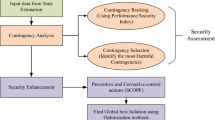Abstract
In this paper, a new fuzzy adaptive artificial physics optimization (FAAPO) algorithm is used to solve security-constrained optimal power flow (SCOPF) problem with wind and thermal power generators. The stochastic nature of wind speed is modeled as a Weibull probability density function. The production cost is modeled with the overestimation and underestimation of available wind energy and included in the conventional SCOPF. Wind generation cost model comprises two components, viz. reserve capacity cost for wind power surplus and penalty cost for wind power shortage. The selection of optimal gravitational constant (G) is a tedious process in conventional artificial physics optimization (APO) method. To overcome this limitation, the gravitational constant (G) is fuzzified in this work. Therefore, based upon the requirement, the gravitational constant changes adaptively. Hence, production cost is reduced, settles at optimum point and takes less number of iterations. The proposed algorithm is tested on IEEE 30-bus system and Indian 75-bus practical system, including wind power in both the test systems. It is observed that FAAPO can outperform BAT algorithm and APO algorithm. Hence, the proposed algorithm can be used for integration of wind power with thermal power generators.















Similar content being viewed by others
References
Stott B, Alsac O, Monticelli AJ (1987) Security analysis and optimization. Proc IEEE 75:1623–1644. doi:10.1109/PROC.1987.13931
Morison K, Wang L, Kundur P (2004) Power system security assessment. IEEE Power Energy Mag 2:30–39. doi:10.1109/MPAE.2004.1338120
Heier S (2014) Grid integration of wind energy conversion systems. Wiley, London
Hervás-Martínez C, Salcedo-Sanz S, Gutiérrez PA et al (2012) Evolutionary product unit neural networks for short-term wind speed forecasting in wind farms. Neural Comput Appl 21:993–1005. doi:10.1007/s00521-011-0582-x
Damousis IG, Alexiadis MC, Theocharis JB, Dokopoulos PS (2004) A fuzzy model for wind speed prediction and power generation in wind parks using spatial correlation. IEEE Trans Energy Convers 19:352–361. doi:10.1109/TEC.2003.821865
Brown BG, Katz RW, Murphy AH (1984) Time series models to simulate and forecast wind speed and wind power. J Clim Appl Meteorol 23:1184–1195. doi:10.1175/1520-0450(1984)023<1184:TSMTSA>2.0.CO;2
Hetzer J, Yu DC, Bhattarai K (2008) An economic dispatch model incorporating wind power. IEEE Trans Energy Convers 23:603–611. doi:10.1109/TEC.2007.914171
Liu X (2010) Economic load dispatch constrained by wind power availability: a wait-and-see approach. IEEE Trans Smart Grid 1:347–355. doi:10.1109/TSG.2010.2057458
Chen H, Chen J, Duan X (2005) Multi-stage dynamic optimal power flow in wind power integrated system. Proc IEEE Power Eng Soc Transm Distrib Conf 2005:1–5. doi:10.1109/TDC.2005.1546979
Chen GCG, Chen JCJ, Duan XDX (2009) Power flow and dynamic optimal power flow including wind farms. Int Conf Sustain Power Gener Supply. doi:10.1109/SUPERGEN.2009.5348135
Jabr RA, Pal BC (2009) Intermittent wind generation in optimal power flow dispatching. IET Gener Transm Distrib 3:66–74. doi:10.1049/iet-gtd:20080273
Shi L, Wang C, Yao L et al (2012) Optimal power flow solution incorporating wind power. IEEE Syst J 6:233–241. doi:10.1109/JSYST.2011.2162896
Panda A, Tripathy M (2014) Optimal power flow solution of wind integrated power system using modified bacteria foraging algorithm. Int J Electr Power Energy Syst 54:306–314. doi:10.1016/j.ijepes.2013.07.018
Mishra C, Singh SP, Rokadia J (2015) Optimal power flow in the presence of wind power using modified cuckoo search. IET Gener Transm Distrib 9:615–626. doi:10.1049/iet-gtd.2014.0285
Armaghani S, Amjady N, Abedinia O (2015) Security constrained multi-period optimal power flow by a new enhanced artificial bee colony. Appl Soft Comput J 37:382–395. doi:10.1016/j.asoc.2015.08.024
Güçyetmez M, Çam E (2015) A new hybrid algorithm with genetic-teaching learning optimization (G-TLBO) technique for optimizing of power flow in wind-thermal power systems. Electr Eng. doi:10.1007/s00202-015-0357-y
Pandiarajan K, Babulal CK (2011) Overload alleviation in electric power system using fuzzy logic. Int Conf Comput Commun Electr Technol (ICCCET). doi:10.1109/ICCCET.2011.5762511
Rezaee Jordehi A (2015) Optimal setting of TCSCs in power systems using teaching–learning-based optimisation algorithm. Neural Comput Appl 26:1249–1256. doi:10.1007/s00521-014-1791-x
Lima FGM, Galiana FD, Kockar I, Munoz J (2003) Phase shifter placement in large-scale systems via mixed integer linear programming. IEEE Trans Power Syst 18:1029–1034. doi:10.1109/TPWRS.2003.814858
Alsac O, Bright J, Prais M, Stott B (1990) Further developments in LP-based optimal power flow. IEEE Trans Power Syst 5:697–711. doi:10.1109/59.65896
Rezaee Jordehi A, Jasni J, Abd Wahab N et al (2015) Enhanced leader PSO (ELPSO): A new algorithm for allocating distributed TCSC’s in power systems. Int J Electr Power Energy Syst 64:771–784. doi:10.1016/j.ijepes.2014.07.058
Rezaee Jordehi A (2015) Chaotic bat swarm optimisation (CBSO). Appl Soft Comput J 26:523–530. doi:10.1016/j.asoc.2014.10.010
Jiang S, Ji Z, Shen Y (2014) A novel hybrid particle swarm optimization and gravitational search algorithm for solving economic emission load dispatch problems with various practical constraints. Int J Electr Power Energy Syst 55:628–644. doi:10.1016/j.ijepes.2013.10.006
Rezaee Jordehi A (2014) A chaotic-based big bang-big crunch algorithm for solving global optimisation problems. Neural Comput Appl 25:1329–1335. doi:10.1007/s00521-014-1613-1
Al Khaled A, Hosseini S (2015) Fuzzy adaptive imperialist competitive algorithm for global optimization. Neural Comput Appl 26:813–825. doi:10.1007/s00521-014-1752-4
Neshat Mehdi (2013) fuzzy adaptive informed particle swarm optimization. Neural Comput Appl 23:95–116. doi:10.1007/s00521-012-1256-z
Xie L, Zeng J, Cui Z (2009) General framework of artificial physics optimization algorithm. In: 2009 world congress on nature and biologically inspired computing (NABIC). pp 1321–1326
Sunitha R, Sreerama K R, Mathew A T (2009) Development of a composite security index for static security evaluation. IEEE region 10 annual international conference, proceedings/TENCON pp 1–6. doi:10.1109/TENCON.2009.5396229
Gandomi AH, Yang XS, Alavi AH, Talatahari S (2013) Bat algorithm for constrained optimization tasks. Neural Comput Appl 22:1239–1255. doi:10.1007/s00521-012-1028-9
Wind data (2014). http://www.nrel.gov/
IEEE 30-bus system (1993). http://www.ee.washington.edu/
Raglend IJ, Padhy NP (2006) Solutions to practical unit commitment problems with operational, power flow and e nvironmental constraints. IEEE Power Eng Soc Gen Meet 247667:1–8. doi:10.1109/PES.2006.1708996
Author information
Authors and Affiliations
Corresponding author
Rights and permissions
About this article
Cite this article
Teeparthi, K., Vinod Kumar, D.M. Security-constrained optimal power flow with wind and thermal power generators using fuzzy adaptive artificial physics optimization algorithm. Neural Comput & Applic 29, 855–871 (2018). https://doi.org/10.1007/s00521-016-2476-4
Received:
Accepted:
Published:
Issue Date:
DOI: https://doi.org/10.1007/s00521-016-2476-4




